When it comes to wireless phone carriers, Sprint and Verizon are two of the leading choices of smartphone users in the U.S. They’re both established with a single goal in mind and that is to provide high-quality wireless service at a reasonable price. From sending messages to your friends and family to reading news online, these networks help you fulfill your basic connectivity needs with great ease. As competing companies, however, Sprint and Verizon provide different unlimited plans with corresponding features. So, if you’re planning to sign up for an unlimited plan but not sure which to pick from the Sprint vs. Verizon competition, you’re in the right place.
This article will guide you through the features of each network. They will be compared in the following categories: Plans & Pricing, Coverage & Performance, Perks & Discounts, Customer Service, and Supported Devices. We’ll select a winner for each category to help you decide which one is the best for you.
How to Choose Between Sprint and Verizon?
Deciding which network offers the best unlimited plan isn’t a one-size-fits-all decision. Remember, we all have varying degrees of needs and circumstances so what’s “better” for you may not be the same for other people. Some cellphone users may live in fairly remote areas so a network with good coverage and faster speed will carry more weight for them. Others who live in the metropolis won’t have any problems with connectivity and speed, so they would probably choose a low-priced unlimited plan with decent service quality.
If you’re having a hard time choosing your pick, don’t forget to establish clear criteria in mind. Considering your geographic location, as well as your ideal budget, service, and speed, are few of the key points you have to watch out as you compare these big networks. Doing this will lighten up the decision-making and will aid you in knowing which you should go for in the Sprint vs. Verizon competition.
Sprint vs. Verizon: An Overview
Here’s a quick run-down of our comparison between Sprint and Verizon. If you want to find out an in-depth analysis of this result, scroll down below to read more.
| Sprint | Verizon | |
|---|---|---|
| Plans & Pricing | 👑**Sprint wins | |
| Coverage & Performance | 👑 **Verizon wins | |
| Perks & Discounts | 👑**Sprint wins | |
| Customer Service | 👑 **Verizon wins |
Sprint vs. Verizon: Coverage & Performance
Are you tired of seeing the “Mobile Network Not Available“ error on your smartphone? Then you should consider choosing a network that supports a wide area coverage. After all, what’s the use of your subscription to a low-cost unlimited plan if the connectivity is slow and intermittent? You won’t get the most out of the service and it messes up your daily routines as well. Hence, understanding the coverage differences of Sprint vs. Verizon is a must and we’re here to help you out.
| Mobile Carrier | Percentage of U.S. Coverage | Percentage of 4G Reception |
|---|---|---|
| Sprint | 30% | 92.5% |
| Verizon | 70% | 95.9% |
Sprint Network Coverage & 4G Speed
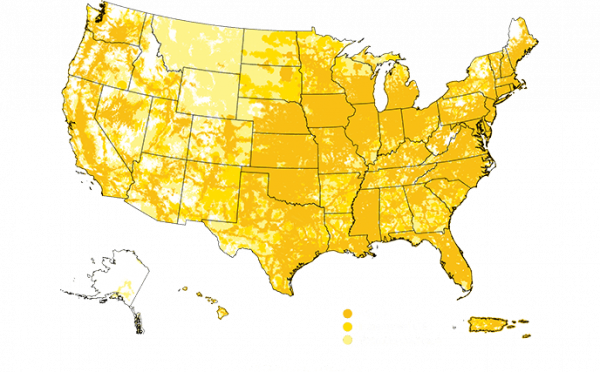
Here’s the thing and this is probably not a secret to you: Sprint’s network coverage is the fourth-best of all the major mobile carriers in the U.S. That means the network is behind Verizon, T-Mobile, and AT&T, and its 4G LTE network covers just about 30% of the country. So if you’re a frequent traveler and you often go to far-flung areas of the United States, Sprint’s connectivity may pose a huge issue to your convenience.
However, if you reside in highly-populated metropolitan areas, chances are you’ll get a solid 4G LTE network without any fuss. That’s because Sprint excels excellently in urban areas but comes with less reliable coverage throughout the Great Plains and western states. Moreover, you experience weak or no coverage at all in the following areas:
- Sparsely-populated areas of California
- Spotty areas throughout Midwest, West, Dakotas to Nevada, and the Middle and South of New England
Apart from this, you also want to make sure that you’re getting a reasonable 4G LTE speed. Fortunately, Sprint users experience 4G reception 92.5% of the time, per the data gathered by OpenSignal. These figures entail that the network offers a good 4G connection as long as the area you’re in is part of the network’s coverage.
Verizon Network Coverage & 4G Speed
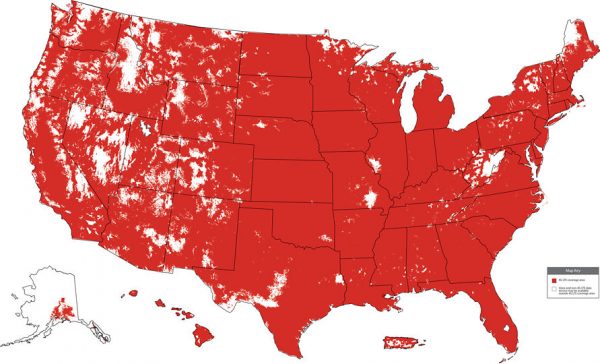
When it comes to network coverage, nothing beats Verizon. In fact, data show that the network covers most areas of the U.S. including the outlying places that have been underserved by most mobile carriers. That said, if you travel across the country and often rely on your mobile connection, Verizon is the best option. With over 70% of network coverage and a whopping 95.9% of 4G reception, this mobile carrier won’t disappoint you at any cost, especially when you’re in need of a reliable 4G LTE connection.
Do note, however, that there are still U.S. areas experiencing weakness using Verizon. Those include:
- Non-metropolitan areas of Alaska
- Spotty areas throughout the middle South and Northeast, the western U.S., and along the west coast.
The Verdict on Coverage & Performance
Who wins in the coverage & performance competition of Sprint vs. Verizon? The data above clearly shows who owns the crown and it’s no other than Verizon. If your main concern is the network coverage and internet speed, you can never go wrong with Verizon.
Sprint vs. Verizon: Plans & Pricing
Another crucial factor to consider when choosing between Sprint vs. Verizon is the available plans and pricing. Your expected speed performance and similar services will always depend on the plan you choose. For instance, you’re a frequent streamer of videos on YouTube so you’re better off with a plan with no data or speed cap. On the other hand, if you often make international calls, then choosing something with roaming privileges will work for you. Hence, it’s necessary to evaluate the features of the plan you’re going to choose in order to make the most out of your monthly subscription fee.
So, you’re eyeing a specific plan that you think is suitable for you. Now, let’s talk about the price. In most cases, choosing an unlimited plan with more add-ons is equivalent to a higher price tag. However, what’s expensive in one network might be cheaper on the other. That’s why it’s important to determine your budget first and the respective offerings of each network before you avail of any of the plans right off the bat.
Sprint’s Unlimited Plans
| Number of Lines | Unlimited Plus | Basic Unlimited | Unlimited Premium |
|---|---|---|---|
| 1 Line | $70 | $60 | $80 |
| 2 Lines | $100 | $100 | $140 |
| 3 Lines | $130 | $100 | $160 |
| 4 Lines | $140 | $100 | $180 |
Sprint Unlimited Plus
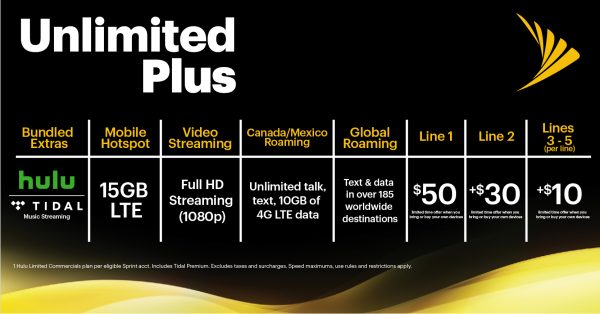
Coming in at $70 per month, it is one of the cheapest unlimited plans available in the market. It includes unlimited HD video streaming, unlimited talk and text in the U.S., a whopping 50 GB hotspot allowance, and likewise a 50 GB deprioritization threshold so you can eliminate the “slowing of connection” once you’ve reached a certain amount of data in a month. Moreover, it features 10 GB of data in Mexico and Canada, as well as unlimited texting to and from selected 185 countries.
What if I tell you that this option also includes Hulu and TIDAL subscription? You read that right. Sprint makes sure that you experience the best of all worlds by giving you what you need and want.
Sprint Unlimited Basic
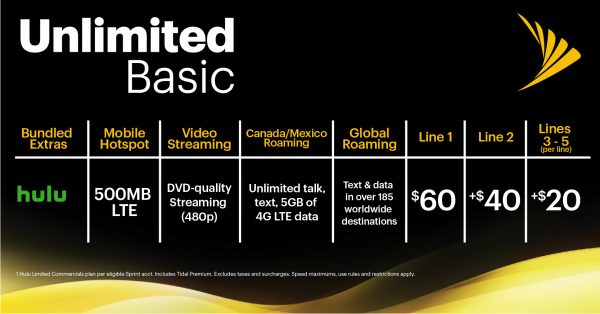
With this plan, you’ll get unlimited calls, text, and high-speed data. However, it doesn’t support HD streaming and the hotspot allowance is limited to 500 MB. Gaming is also restricted to 2 Mbps speed, and music streaming to 500 kbps.
If you often cross borders, you get 5 GB of 4G LTE data in Canada and Mexico, with the ability to send and receive text messages to and from 185 countries. You can still watch your favorite shows on Hulu since this option comes with a Hulu subscription. Get all these features for only $60 per month or $100 for a minimum of four lines.
Sprint Unlimited Premium
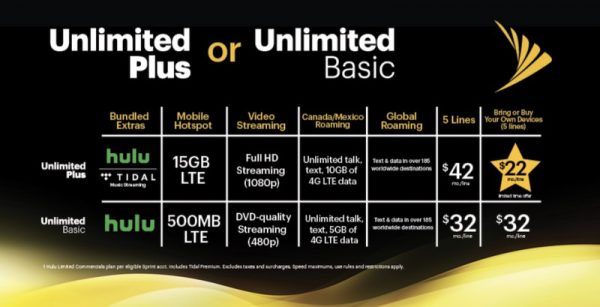
Unlimited Premium is probably the most expensive Sprint plan, but it also has the most features compared to others previously mentioned. For $80 per month, you get a slew of incredible bundle deals such as Amazon Prime, Hulu, and TIDAL subscriptions. If you often use your cellular data to connect your other devices to the internet, then this plan is definitely the plan for you. It boasts a hefty 100 GB hotspot allowance, and unlimited 4G LTE connection both in Mexico and Canada.
This option is certainly a notch above others since no other carrier includes unlimited data to Mexico and Canada privileges.
Verizon’s Unlimited Plans
| Number of Lines | Start Unlimited | Play More Unlimited | Do More Unlimited | Get More Unlimited |
|---|---|---|---|---|
| 1 Line | $70 | $80 | $80 | $90 |
| 2 Lines | $120 | $140 | $140 | $160 |
| 3 Lines | $135 | $165 | $165 | $195 |
| 4 Lines | $140 | $180 | $180 | $220 |
Start Unlimited

If you’re new to Verizon, then you might want to check out Start Unlimited. It’s the most basic plan of the network and it comes with unlimited calls, texts, and high-speed 4G LTE data. Be wary, however, that the speed might throttle a bit if the network gets congested. Canada and Mexico are also included in the calls, texts, and data features. Likewise, you get video streaming up to 480p but no mobile hotspot allowance.
Start Unlimited doesn’t stop there. It also includes one year of Disney+ subscription and six months of Apple Music for free. You can get all these components for $70 per month for a single line up to $140 for four lines, auto-pay included. However, keep in mind that there are still added taxes and fees to the final amount.
Play More Unlimited

Like Stars Unlimited, Play More Unlimited offers the same unlimited calls, texts, and 4G LTE data in the U.S., including calls, texts, and data in Mexico and Canada. Unlike Start Unlimited, however, this plan has a 15 GB of 4G LTE mobile hotspot allowance. Still, the connection tends to slow down when you’ve consumed 25 GB data per line.
With Play More Unlimited, you can stream videos in HD (720p), including a one-year Disney+ and full Apple Music subscriptions. This plan costs $80 per month (with auto-pay) for a single line. However, if you avail four lines under this tier, you’ll pay $180 with auto-pay. Taxes and other fees still apply.
Do More Unlimited

Do More unlimited is highly similar to Play More Unlimited. You’ll get the same unlimited calls, texts, and 4G LTE data in the U.S., as well as in Mexico and Canada. The 15 GB 4G LTE mobile hotspot allowance still applies. The only difference is that you’re given a 50 GB deprioritization threshold per line and the ability to stream videos in 480p.
Other features include a one-year Disney+ and six months of Apple Music subscription. This time, you’ll get the added 500 GB of Verizon Cloud Storage for free. This plan costs the same as Play More, which is $80 per month (with auto-pay). The four-line option also comes in $180 per month, auto-pay included. Don’t forget to add taxes and other fees on the sum.
Get More Unlimited

If you prefer to go all premium, then check out Get More Unlimited. It’s the top-of-the-line unlimited plan of Verizon, and it features the best perks among all plans.
With this plan, you’ll get unlimited calls, texts, and 4G LTE data with Mexico and Canada included. Plus, it has a whopping 75 GB of data deprioritization threshold and HD-quality 720p video streaming. From 15 GB mobile hotspot allowance, you get an additional 15 GB in this plan so that’s 30 GB of 4G LTE mobile hotspot per month.
Other features include one-year Disney+, full Apple Music subscription, and 500 GB of Verizon Cloud Storage. Get More Unlimited costs $90 per month with auto-pay, but it’ll only cost $220 per month (auto-pay included) for four lines. Taxes and other fees still apply, though.
The Verdict on Plans and Pricing
You’ve seen all of Sprint vs. Verizon’s unlimited plans. Now comes the question, who wins? All of their plans are great and they have all separate benefits. But if you’re leaning toward the price factor, we’d certainly say that Sprint takes the lead here. Cheaper plans with full perks, that’s definitely gold.
Sprint vs. Verizon: Perks & Discounts
You probably already have an idea who wins here. As mentioned in the Plans & Pricing section, both mobile carriers offer great perks and bundles to their unlimited plans. All of Sprint’s unlimited plans come with Hulu subscription, with international data and texting to over 185 countries. Bumping up to the Plus level gives you a full subscription to TIDAL. Lastly, the Premium tier entitles you to TIDAL, Hulu, and Amazon Prime subscriptions.
If you take a look at Verizon, well, the network doesn’t give you many perks compared to Sprint. Sure you’ll get Disney+ subscription, but that’s only limited to a year. Most of Verizon’s unlimited plans come with Apple Music but only for six months. Upgrading to the high-end tiers, however, gives you a full subscription to Apple Music and an additional 500 GB of Verizon Cloud Storage.
The Verdict on Perks and Discounts
There’s no denying that Sprint has the best special features at a lower price tag. You’ll get full premium subscriptions from three major services. If you’re going to subscribe to these big names individually, they would cost a lot so Sprint gets this round.
Sprint vs. Verizon: Customer Service
Customer Service is another factor to consider when choosing between Sprint vs. Verizon. Let’s say you’ve encountered an error and you have no idea how to troubleshoot it, where do you turn to? Of course, your network’s customer service. Now, imagine sending your query to a customer service representative but not receiving a reply. That’s frustrating. So, who wins in the Customer Service category? Let’s find out.
In the recent study conducted by J.D Power, Verizon ranks second for customer service, with 4 out of 5 power circles. On the other hand, Sprint comes last with just two power circles. What does it mean? It’s pretty simple, most of Verizon’s consumers are highly satisfied with the network’s customer service performance. All of their needs and concerns are properly addressed, with immediate actions to each issue.
The Verdict on Customer Service
The data shows that Verizon wins, hands down.
Final Word
We’ve laid out the facts, and we’ve given an in-depth analysis of them. Now, the choice is all up to you. Just like we’ve said, people’s needs are completely different from each other. Verizon might be a huge deal for some, so is Sprint for the others. If you’re on a low budget but live in an area supported by both networks, then Sprint is certainly the best option to grab. With lower costs and undeniably great perks, you can never go wrong with it.
On the other hand, if your primary concern is all about the coverage and customer service, then you should undoubtedly go with Verizon. They may have expensive unlimited plans but the few extra bucks are worth the costs since the network supports widespread coverage, you wouldn’t have to worry about losing signals wherever you go. In case that happens, their customer service is readily reachable and can address your issues in no time.
